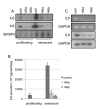MicroRNAs miR-146a/b negatively modulate the senescence-associated inflammatory mediators IL-6 and IL-8
- PMID: 20148189
- PMCID: PMC2818025
- DOI: 10.18632/aging.100042
MicroRNAs miR-146a/b negatively modulate the senescence-associated inflammatory mediators IL-6 and IL-8
Abstract
Senescence is a cellular program that irreversibly arrests the proliferation of damaged cells and induces the secretion of the inflammatory mediators IL- 6 and IL-8 which are part of a larger senescence associated secretory phenotype (SASP). We screened quiescent and senescent human fibroblasts for differentially expressed microRNAS (miRNAs) and found that miRNAs 146a and 146b (miR-146a/b) were significantly elevated during senescence. We suggest that delayed miR-146a/b induction might be a compensatory response to restrain inflammation. Indeed, ectopic expression of miR-146a/b in primary human fibroblasts suppressed IL-6 and IL-8 secretion and downregulated IRAK1, a crucial component of the IL-1 receptor signal transduction pathway. Cells undergoing senescence without induction of a robust SASP did not express miR-146a/b. Further, IL-1alpha neutralizing antibodies abolished both miR-146a/b expression and IL-6 secretion. Our findings expand the biological contexts in which miRNA-146a/b modulates inflammatory responses. They suggest that IL-1 receptor signaling initiates both miR-146a/b upregulation and cytokine secretion, and that miR-146a/b is expressed in response to rising inflammatory cytokine levels as part of a negative feedback loop that restrains excessive SASP activity.
Keywords: DNA damage; IL-1α; IL-6; IL-8; inflammation; miRNA.
Conflict of interest statement
There is no conflict of interest for any of the authors.
Figures





References
-
- Campisi J. Senescent cells, tumor suppression, and organismal aging: good citizens, bad neighbors. Cell. 2005;120:513–522. - PubMed
-
- Campisi J, d'Adda di Fagagna F. Cellular senescence: when bad things happen to good cells. Nat Rev Mol Cell Biol. 2007;8:729–740. - PubMed
-
- Lundberg AS, Hahn WC, Gupta P, Weinberg RA. Genes involved in senescence and immortalization. Curr Opin Cell Biol. 2000;12:705–709. - PubMed
-
- Serrano M, Blasco MA. Putting the stress on senescence. Curr Opin Cell Biol. 2001;13:748–753. - PubMed
-
- Demidenko ZN, Blagosklonny MV. Growth stimulation leads to cellular senescence when the cell cycle is blocked. Cell Cycle. 2008;7:3355–3361. - PubMed
Publication types
MeSH terms
Substances
Grants and funding
LinkOut - more resources
Full Text Sources
Other Literature Sources
Medical
